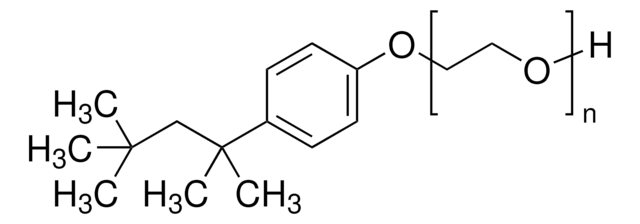M8005
Sodium myristate
≥99%
Synonym(s):
Myristic acid sodium salt, Tetradecanoic acid sodium salt
Sign Into View Organizational & Contract Pricing
All Photos(2)
About This Item
Linear Formula:
CH3(CH2)12COONa
CAS Number:
Molecular Weight:
250.35
Beilstein:
3575157
EC Number:
MDL number:
UNSPSC Code:
12352211
PubChem Substance ID:
NACRES:
NA.25
Recommended Products
biological source
plant (vegetable)
Quality Level
Assay
≥99%
form
powder
functional group
ester
lipid type
saturated FAs
shipped in
ambient
storage temp.
2-8°C
SMILES string
[Na+].CCCCCCCCCCCCCC([O-])=O
InChI
1S/C14H28O2.Na/c1-2-3-4-5-6-7-8-9-10-11-12-13-14(15)16;/h2-13H2,1H3,(H,15,16);/q;+1/p-1
InChI key
JUQGWKYSEXPRGL-UHFFFAOYSA-M
Looking for similar products? Visit Product Comparison Guide
Related Categories
Biochem/physiol Actions
Myristate (tetradecanoic acid) is a saturated (C14:0) medium-chain fatty acid. Sodium myristate is used in surfactant, cholloidal and hydrophobic/absorption chemistry involving molecules such as proteins.
Myristic acid is commonly added via a covalent linkage to the N-terminal glycine of many eukaryotic and viral proteins, a process called myristoylation. Myristoylation enables proteins to bind to cell membranes and facilitates protein-protein interactions. Myristolyation of proteins affect many cellular functions and thus has implications in health and disease .
Storage Class Code
11 - Combustible Solids
WGK
WGK 1
Flash Point(F)
Not applicable
Flash Point(C)
Not applicable
Personal Protective Equipment
dust mask type N95 (US), Eyeshields, Gloves
Choose from one of the most recent versions:
Already Own This Product?
Find documentation for the products that you have recently purchased in the Document Library.
Erika M Hernández et al.
Journal of colloid and interface science, 250(2), 271-280 (2005-11-18)
Fibrinogen (FB), a serum protein, is considered a major inhibitor of lung surfactant function at the lining layer of the alveoli. In this study, the adsorption of aqueous bovine FB at the air/water interface was investigated with tensiometry and directly
Wen et al.
Journal of colloid and interface science, 231(1), 42-51 (2000-11-18)
Aqueous sodium myristate solutions have been shown to have unusually low dynamic tensions (1-10 mN/m) under pulsating area conditions. These solutions have no sharp solubility limit, evidently because they are protonated (or "hydrolyzed") to form the much less soluble myristic
Scott J McClellan et al.
Langmuir : the ACS journal of surfaces and colloids, 21(22), 10148-10153 (2005-10-19)
The competitive adsorption of proteins and surfactants has applications to chromatographic systems and biological materials. Adsorption for systems of bovine serum albumin (BSA) and sodium myristate (SM) was investigated with in-situ ATR-IR spectroscopy and ex-situ ellipsometry. The results were used
Ali Hossain Khan et al.
ACS nano, 14(4), 4206-4215 (2020-04-11)
Colloidal two-dimensional (2D) nanoplatelet heterostructures are particularly interesting as they combine strong confinement of excitons in 2D materials with a wide range of possible semiconductor junctions due to a template-free, solution-based growth. Here, we present the synthesis of a ternary
Dániel Zámbó et al.
Small (Weinheim an der Bergstrasse, Germany), 16(16), e1906934-e1906934 (2020-03-13)
3D nanoparticle assemblies offer a unique platform to enhance and extend the functionality and optical/electrical properties of individual nanoparticles. Especially, a self-supported, voluminous, and porous macroscopic material built up from interconnected semiconductor nanoparticles provides new possibilities in the field of
Our team of scientists has experience in all areas of research including Life Science, Material Science, Chemical Synthesis, Chromatography, Analytical and many others.
Contact Technical Service







